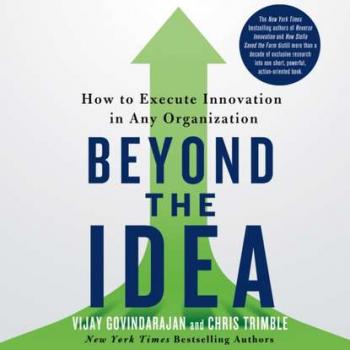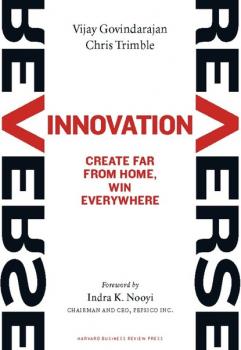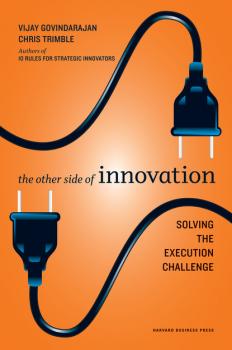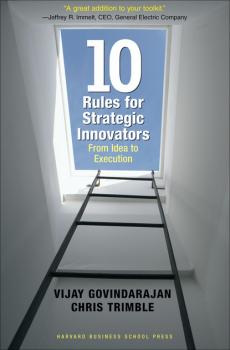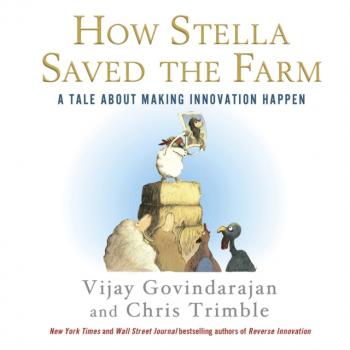ТОП просматриваемых книг сайта:















Vijay Govindarajan
Список книг автора Vijay GovindarajanАннотация
Аннотация
A year’s worth of management wisdom, all in one place. We’ve reviewed the ideas, insights, and best practices from the past year of Harvard Business Review to keep you up-to-date on the most cutting-edge, influential thinking driving business today. With authors from Clayton M. Christensen to Adam Grant and company examples from Intel to Uber, this volume brings the most current and important management conversations to your fingertips. This book will inspire you to: Rethink the way you work in the face of advancing automationTransform your business using a platform strategyApply design thinking to create innovative productsIdentify where too much collaboration may be holding your people backSee the theory of disruptive innovation in a brand new lightRecognize the signs that your cross-cultural negotiation may be falling apart This collection of articles includes “Collaborative Overload,” by Rob Cross, Reb Rebele, and Adam Grant; “Algorithms Need Managers, Too,” by Michael Luca, Jon Kleinberg, and Sendhil Mullainathan; “Pipelines, Platforms, and the New Rules of Strategy,” by Marshall W. Van Alstyne, Geoffrey G. Parker, and Sangeet Paul Choudary; “What Is Disruptive Innovation?,” by Clayton M. Christensen, Michael Raynor, and Rory McDonald; “How Indra Nooyi Turned Design Thinking into Strategy,” an interview with Indra Nooyi by Adi Ignatius; “Engineering Reverse Innovations,” by Amos Winter and Vijay Govindarajan; “The Employer-Led Health Care Revolution,” by Patricia A. McDonald, Robert S. Mecklenburg, and Lindsay A. Martin; “Getting to Sí, Ja, Oui, Hai, and Da,” by Erin Meyer; “The Limits of Empathy,” by Adam Waytz; “People Before Strategy: A New Role for the CHRO,” by Ram Charan, Dominic Barton, and Dennis Carey; and “Beyond Automation,” by Thomas H. Davenport and Julia Kirby.
Аннотация
How to Innovate and ExecuteLeaders already know that innovation calls for a different set of activities, skills, methods, metrics, mind-sets, and leadership approaches. And it is well understood that creating a new business and optimizing an already existing one are two fundamentally different management challenges. The real problem for leaders is doing both, simultaneously. How do you meet the performance requirements of the existing business—one that is still thriving—while dramatically reinventing it? How do you envision a change in your current business model before a crisis forces you to abandon it?Innovation guru Vijay Govindarajan expands the leader’s innovation tool kit with a simple and proven method for allocating the organization’s energy, time, and resources—in balanced measure—across what he calls “the three boxes”:• Box 1: The present—Manage the core business at peak profitability• Box 2: The past—Abandon ideas, practices, and attitudes that could inhibit innovation• Box 3: The future—Convert breakthrough ideas into new products and businessesThe three-box framework makes leading innovation easier because it gives leaders a simple vocabulary and set of tools for managing and measuring these different sets of behaviors and activities across all levels of the organization. Supported with rich company examples—GE, Mahindra & Mahindra, Hasbro, IBM, United Rentals, and Tata Consultancy Services—and testimonies of leaders who have successfully used this framework, this book solves once and for all the practical dilemma of how to align an organization on the critical but competing demands of innovation.
HBR's 10 Must Reads on Innovation (with featured article "The Discipline of Innovation," by Peter F. Drucker) - Vijay Govindarajan
HBR's 10 Must ReadsАннотация
To innovate profitably, you need more than just creativity. Do you have what it takes? If you read nothing else on inspiring and executing innovation, read these 10 articles. We’ve combed through hundreds of articles in the Harvard Business Review archive and selected the most important ones to help you innovate effectively. Leading experts such as Clayton Christensen, Peter Drucker, and Rosabeth Moss Kanter provide the insights and advice you need to:Decide which ideas are worth pursuingInnovate through the front lines—not just from the topAdapt innovations from the developing world to wealthier marketsTweak new ventures along the way using discovery-driven planningTailor your efforts to meet customers’ most pressing needsAvoid classic pitfalls such as stifling innovation with rigid processes
Аннотация
A New York Times, Wall Street Journal, USA Today, Amazon BestsellerReverse Innovation is the new business idea everyone is talking about. Why? Because it presents the blueprint for scaling growth in emerging markets, and importing low-cost and high impact innovations to mature ones.Innovation is no longer the exclusive domain of the Silicon Valley elite. Reverse Innovation will open your eyes to the fact that the dynamics of global innovation are changing—and if you want your firm to survive, you’d better pay attention. The gap between rich nations and emerging economies is closing. No longer will innovations travel the globe in only one direction, from developed to developing nations. They will also flow in reverse. CEOs of the world’s most influential companies agree and have cited Reverse Innovation as their playbook for the next generation of global growth. Authors Vijay Govindarajan and Chris Trimble of the Tuck School of Business at Dartmouth explain where, when, and why reverse innovation is on the rise and why the implications are so profound. Learn how to make innovation in emerging markets happen and how such innovations can unlock even greater opportunity throughout the world. You’ll follow some of the world’s leading companies (including GE, Deere & Company, P&G, and PepsiCo) through stories that illustrate exactly what works and what doesn’t.If you’re in a Western economy, you need to accept that the future lies far from home. But the idea is not just for Western audiences. If innovation is at the heart of your company or your career, no matter where you practice business, Reverse Innovation is a phenomenon you need to understand. This book will help you do that.
Аннотация
In their first book, Ten Rules for Strategic Innovators, the authors provided a better model for executing disruptive innovation. They laid out a three-part plan for launching high-risk/high-reward innovation efforts: (1) borrow assets from the existing firms, (2) unlearn and unload certain processes and systems that do not serve the new entity, and (3) learn and build all new capabilities and skills.In their study of the Ten Rules in action, Govindarajan and Trimble observed many other kinds of innovation that were less risky but still critical to the company's ongoing success. In case after case, senior executives expected leaders of innovation initiatives to grapple with forces of resistence, namely incentives to keep doing what the company has always done–rather than develop new competence and knowledge. But where to begin?In this book, the authors argue that the most successful everyday innovators break down the process into six manageable steps:1. Divide the labor2. Assemble the dedicated team3. Manage the partnership4. Formalize the experiment5. Break down the hypothesis6. Seek the truth.The Other Side of Innovation codifies this staged approach in a variety of contexts. It delivers a proven step-by-step guide to executing (launching, managing, and measuring) more modest but necessary innovations within large firms without disrupting their bread-and-butter business.
Аннотация
Even world-class companies, with powerful and proven business models, eventually discover limits to growth. That's what makes emerging high-growth industries so attractive. Although they lack a proven formula for making a profit, these industries represent huge opportunities for the companies that are fast enough and smart enough. But constructing tomorrow's businesses while simultaneously sustaining excellence in today's, demands a delicate balance. It is a quest fraught with contradiction and paradox. Until now, there has been little practical guidance. Based on an in-depth, multiyear research study of innovative initiatives at ten large corporations, Vijay Govindarajan and Chris Trimble identify three central challenges: forgetting yesterday's successful processes and practices; borrowing selected resources from the core business; and learning how the new business can succeed. The authors make recommendations regarding staffing, leadership roles, reporting relationships, process design, planning, performance assessment, incentives, cultural norms, and much more. Breakthrough growth opportunities can make or break companies and careers. Ten Rules for Strategic Innovators is every leader's guide to execution in unexplored territory.

